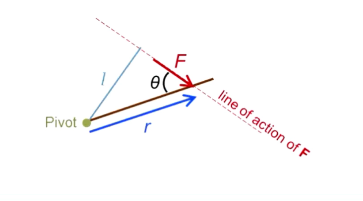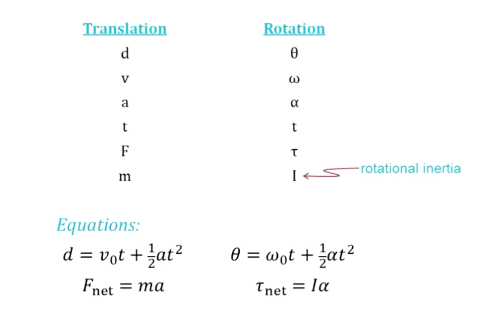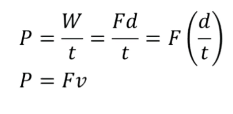Physics Class 2
1/29
There's no tags or description
Looks like no tags are added yet.
Name | Mastery | Learn | Test | Matching | Spaced |
|---|
No study sessions yet.
30 Terms
What are characteristics of uniform circular motion?
Constant speed
Velocity and acceleration are changing
What is centripetal acceleration?
Acceleration pointing inward in uniform circular motion
Perpendicular to velocity
How is centripetal acceleration calculated?
a = v²/r
v = velocity
r = radius

How is centripetal force calculated?
Fnet = Fc
Fc = mv²/r
m = mass
v = velocity
r = radius

What is centripetal force?
Result of the net physical force acting on an object
Cannot change the speed (forces that are perpendicular to velocity cannot do this)
Fnet = Fc
What is apparent weight?
Sum of all forces pointing down
What is center of mass/gravity?
Balance point of an object
Ignoring rotation, we can think of all mass being located here
How is position of the center of mass calculated for non-uniform objects?
Xcm = (m1x1 + m2x2 +…+mnxn)/(m1 + m2 + … + mn)
m = mass
x = position relative to start point (can set anywhere, like an end point)
Ex: teeter totter, mobile, etc.
If the rod has mass, act like it is all located at the center point of the rod

What is torque? Torque’s formula?
Effectiveness of a force at making an object rotate; vector; max when r and F are perpendicular
T = rF sin theta
Units: N*m
r = vector distance from pivot point to where force is applied
theta = angle of F and r

When does normal force do work?
Only when the surface something is on is moving (ex: elevator)
What work does gravity do? Formula
Depends only on initial and final positions of object, regardless of path
Conservative force
Wg = mgh
m = mass
g = gravity
h = height
What is work? Formula?
Measures how much a force contributes to displacement of an object; scalar
W = dF cos theta
d = displacement
F = force (constant)
theta = angle F is applied at
Units = N*m = J
What is the lever arm formula?
T = lF
T = torque
l = length of line perpendicular to force, connected to pivot point
F = force
Alternate formula for torque

What does it mean for something to be in equilibrium?
Net force is 0
What are the equations for rotational motion?
Same as kinematics but change the variables

What is rotational inertia?
I
How hard it is to change something’s rotating
The farther the mass is from axis of rotation, the larger I is
What is power?
Rate at which work is done
Units = W (watts)
P = W/t
W = work
t = time

What is power for a constant force parallel to constant velocity?
P = Fv
F = force
v = velocity

What is kinetic energy?
Scalar; energy of motion
KE = 1/2 mv²
m = mass
v = velocity
Units = J
What is energy?
Ability to do work
What is the work energy theorem?
Total work is equal to change in kinetic energy
W total = KEf - KEi
What is potential energy?
Energy that can be transformed from one form to another
PE = mg(hf - hi)

How are work done by gravity and gravitational potential energy related?
W grav = - (PE grav final - PE grav initial)

What is the equation for conservation of mechanical energy?
KEf - KEi = - (PEf - PEi)
(KEf - KEi) + (PEf - PEi) = 0

What are conservative forces? Nonconservative?
Conservative: gravity, electrostatic, spring (forces that have PE associated with them)
Nonconservative: kinetic friction, drag; always do negative work; if they are present, mechanical energy is not conserved
How do you calculate work done by non-conservative forces?
See image

What is mechanical advantage? Formula?
Factor by which force can be reduced when using a machine
MA = F resist/F effort
F = force
MA = d effort/d resist (only for ideal machines with no friction or deformation)
d = displacement

What is efficiency? Formula?
Measure of how close to ideal a system is (ratio of work accomplished to energy supplied)
Eff (%) = (W output / E input) 100
W = work
E = input
For something to stay in place on a spinning, non inclined plane, what is Fc?
Fc = Fstatic Friction = Fnet
What is tension in a string moving something in a circle (ignoring gravity)?
T = Fcentripetal